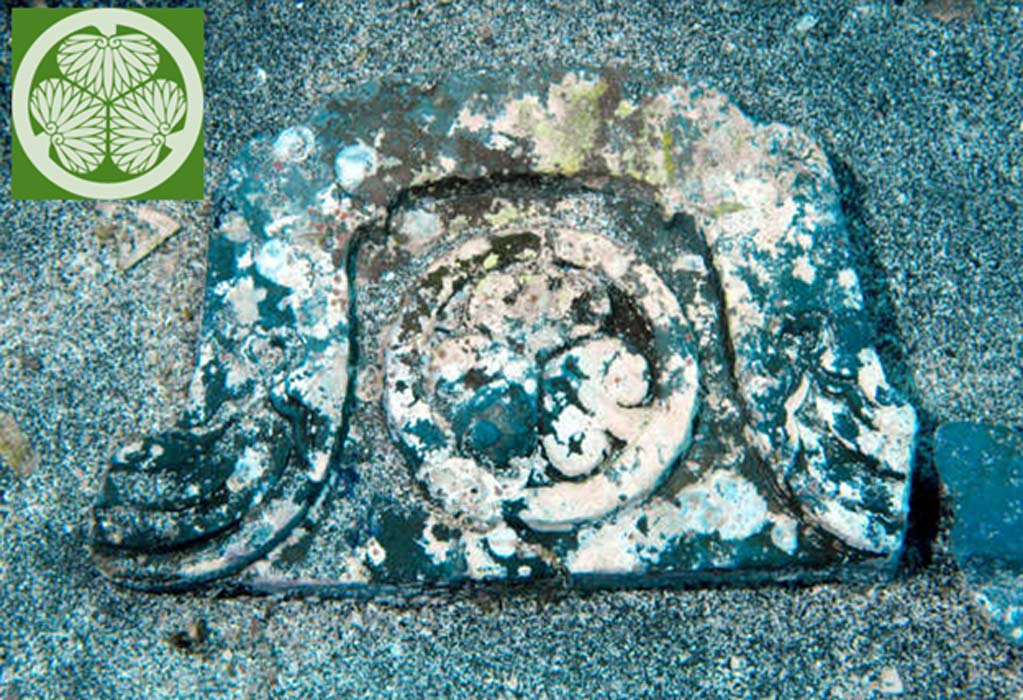Shipwreck’s Cargo Belonged to Most Important Shogun Clan in Japanese History
In recent decades marine archaeology has greatly expanded our knowledge of the past. A Japanese team of marine archaeologists has made an amazing discovery at the bottom of the sea. They have been able to recover much of the cargo from a sunken ship and among the items found is a coat of arms on a roof tile. The family crest belonged to an aristocratic family who dominated Japan for over 300 years.
In December 2018, the Asian Research Institute of Underwater Archaeology investigated the site off Hatushima Island, in the Sagami-nada Sea. Divers from the Institute dived to a depth of almost 70 feet (20 meters) to investigate the wreck of a cargo ship that sank during a storm in the early eighteenth century. Most of the wooden ship has long since disintegrated and very little remains of the vessel. The ship has been sailing between Osaka and Edo (modern Tokyo) when it sank to the bottom of the sea.

Investigators recording of the state of sunken roof tiles off Hatsushima island in Atami, Shizuoka Prefecture, on Dec. 14. (Image: Kazushige Horiguchi / Asahi Shimbun)
The Shipwreck
The site, which has been intermittently studied since 2011, is on the sandy seabed in an area that measures about 15 feet (5 meters) and it includes some hull timbers and many earthenware objects. The divers discovered “countless numbers of roof tiles arranged in an orderly manner and piled up in many tiers” according to the Ashai Shimbun website. They were mostly ordinary roof tiles and not that interesting.
However, one of the divers spotted a “wild ginger trefoil coat of arms of the Tokugawa clan was embossed in bold relief on a ridge-end gargoyle tile in the sandy soil” reports Ashai Shimbun. This was a real and significant discovery and one that has excited the researchers and divers, for they had found the coat of arms of perhaps the most important Shoguns in Japanese history.

A wild ginger trefoil coat of arms of the Tokugawa shogun clan is seen embossed on this ridge-end gargoyle tile off Hatsushima island in Atami, Shizuoka Prefecture, on Dec. 14. (Image: Kazushige Horiguchi / Asahi Shimbun) Inset: Tokugawa coat of arms/crest Public Domain
The Tokugawa Shoguns
The founder of this dynasty was Tokugawa Ieyasu who was one of the generals who helped to reunify Japan after the bloody anarchy of the Sengoku era. In 1600 he defeated the son of the great general Hideyoshi in battle and he became the supreme military power in Japan. In 1603 the Emperor made him Shogun, and this meant ‘Ieyasu achieved hegemony over the entire country’ according to the Encyclopaedia Britannica. Tokugawa and his successors brought peace to the land and demilitarized Japanese society and over time they even tamed the fearsome Samurai warriors who during the rule of the Tokugawa increasingly became public officials and clerks.
Tokugawa Japan
Tokugawa Ieyasu transformed Japanese society and created a system that was designed to prevent another period of war. He later had the Emperor make his son Shogun and members of the clan ruled Japan until the Meji Restoration (1863). One of the many achievements of this shogun was the establishment of Edo or Tokyo. At the start of his rise to power Edo was only a castle but he later made it his power base and capital and Ieyasu can almost be regarded as the founder of the modern metropolis of Tokyo.
- 47 Ronin: The Samurai Warriors that Sought to Avenge the Death of their Master
- The legend of Heikegani: the Samurai ghost crabs

Portrait of Tokugawa Ieyasu from Osaka Castle. (Public Domain)
It seems that the coat of arms on the tile and the other items were to be part of Edo Castle, which was the stronghold of the Tokugawa clan. The tile and the other finds are helping us to have a better understanding of the castle as it was in the 17 th century when it was the center of power in Japan. The palace was made of wood and was destroyed more than once by fire, but the tiles can help experts to reimagine the castle.
The find, on the sandy seabed is telling experts much about the socio-economic and political conditions in Tokugawa, Japan. This dynasty ruled by creating a number of semi-autonomous regional lords or dayimo who governed in their name. The tiles were made in Tanba a province in central Japan and indicate the high level of control that the Tokugawa had in these areas in the late seventeenth and early eighteenth century.
- Searching for the Honjo Masamune, Lost Samurai Sword of Power
- The Curse of the Samurai Muramasa Blades

Portrait of Tokugawa Ieyasu at the Battle of Nagakute. (Public Domain)
The Tokugawa are widely praised for their development of the economy. The discovery of the tile and the other items shows that the peace brought by the Shogunate greatly benefited regional trade. Many of the tiles found were mass produced and indicates that Japan by the early 1700s was an industrial powerhouse by the standards of the time.
The discovery of the site is helping researchers to understand the socio-economic conditions in Japan and even helping them to have a better picture of Edo Castle. It is hoped that there are more discoveries to be made at the site however this maybe hindered due to legal issues. So far, the wreck has not been able to secure legal protection from the government in Tokyo. At present there is a campaign to have the site receive official recognition.
Top image: coat of arms of the Tokugawa shogun clan is seen embossed on this ridge-end gargoyle tile off Hatsushima island in Atami, Shizuoka Prefecture Source: Image: Kazushige Horiguchi / Asahi Shimbun
By Ed Whelan




















Comments
Its not just a clan though. The Tokugawa families were the rulers of the (relatively), peaceful Edo period. Which lasted for over 250 years.